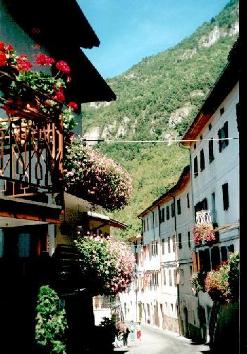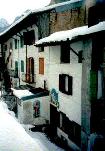 Bordering
upon Trentino Alto Adige, Pedemonte is situated in the
northernmost part of Astico valley. Being under Austro-Hungarian
rule till 1918 as part of a little strip of South Tyrol, it has
impressed its Asbourgical roots in building construction, in
habits and in language.
Bordering
upon Trentino Alto Adige, Pedemonte is situated in the
northernmost part of Astico valley. Being under Austro-Hungarian
rule till 1918 as part of a little strip of South Tyrol, it has
impressed its Asbourgical roots in building construction, in
habits and in language.
"Casotto alto" shows the intimacy of the good old days poetically whispered by the melodious gurgling of its fountain, while, from the balcony adjacent to the church, the gaze stares at the lovely view of the valley with its prehistoric landslide and the mountain "Spitz di Tonezza".
The landscape represents an encouraging and attractive call towards nature. The paths are countless: you can climb towards Krojer (the mountain overhanging Casotto) or Luserna (a village where it is spoken an ancient language called "Cimbro" which is very closed to German) or Lavarone (a village where you can visit the fortress of Belvedere built on the 1st world war). All these tracks were very busy in times past and daily used to join the valley from the table-land (Folgaria - Lavarone - Luserna) or exchange goods between much further lands as it frequently happened between Venice and Trento.
It's such a pleasure to let yourself lead among all these different scenarios scouring the valley of Rio Torto (Pedemonte) and climbing to Malga Laghetto (Lavarone) in order to admire the "Avez del Prinzep", the biggest fir in Europe… or gazing at Gorgo Santo falls which are very suggestive in particular after a heavy rain … or visit the caves of RioTorretta and Rio Molino … or hear from the "Covolo delle Campane" the echo of Brancafora's church bells. Merged into the nature of the left side of Astico valley, it will be easy for you to meet roe deer, chamois and mouflons. ;
Local people's devotion is witnessed by some restored votive constructions disseminated here and there in the village and also by the churches "frazionali" rich in pictorial and wooden subjects as the church of Casotto erected in 1748 (rebuilt in 1920), with its adjacent graveyard belonging to mitteleuropean culture, and the sylvan church of Belfiore at about 748 mt height.
"Santa Maria Assunta" parish church in Brancafora rises very closed to the ancient valley called "Valle dei Frati" (= the valley of monks) , right along the merchant track between Venetian and Austrian lands. Its bell-tower, with its eighteenth-century onion spire, was erected in Tyrolean style. The church was rebuilt in 1876.
Inside the chapel there's some precious sacred furnishing: the sixteenth-century wooden pulpit, an elegant combination of Baroque and RococÚ, made by carvers of "Scuola trentina"
and the sixteenth-century oil-paintings representing the "Way of the Cross".
In Brancafora, closed to the modern
residence area, it's open to everyone a sports center made up of
a gymnasium, a tennis court and a soccer field.
Pedemonte
does not suggest a refined holiday,in fact there are no
accommodating hotels in its nearby,
but it stirs the curiosity of the tourist in his personal quest
of its genuine beauties.